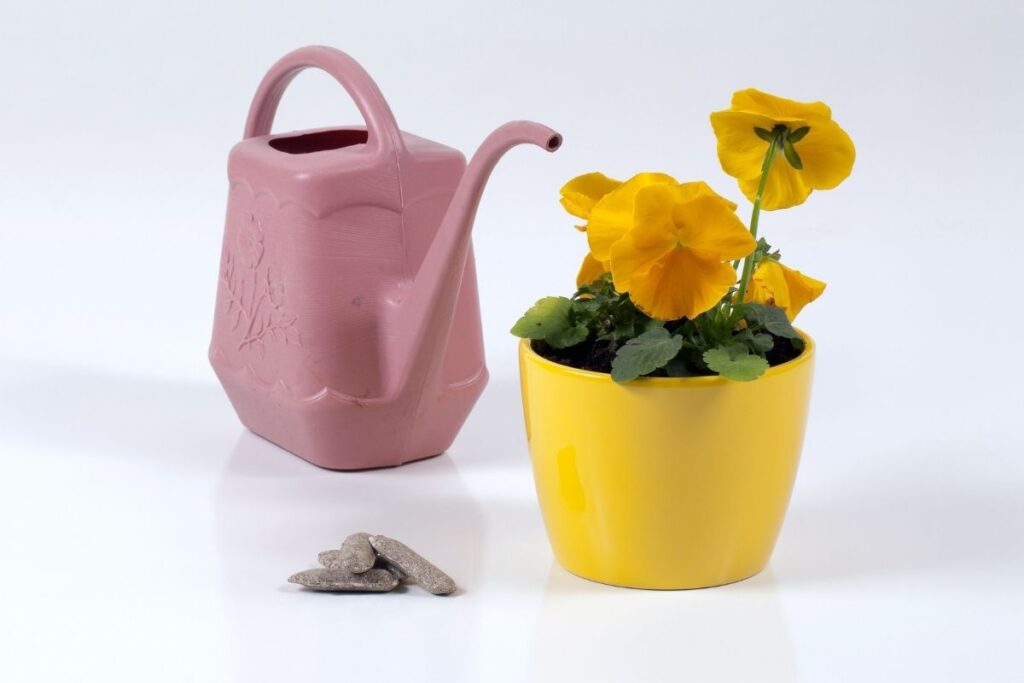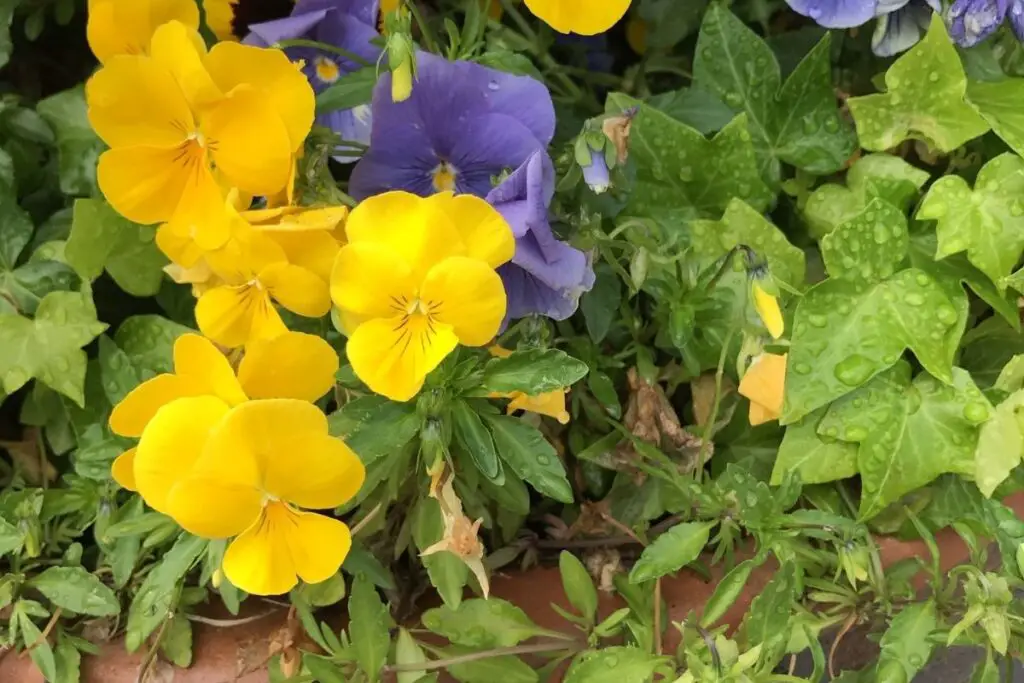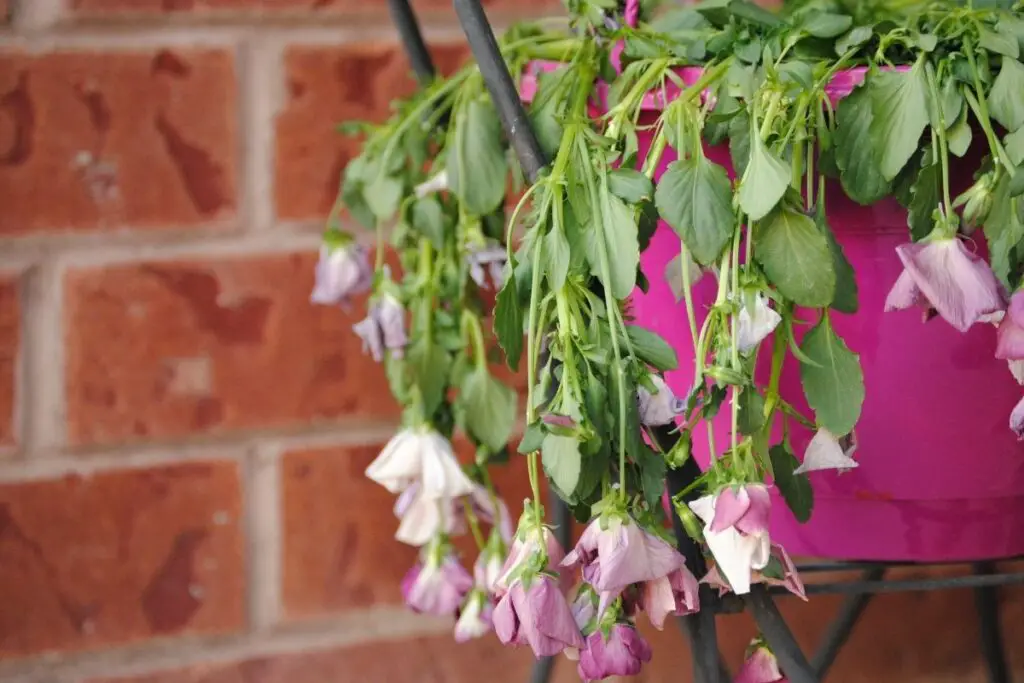Pansies will remain healthy when they are growing in rich humus, evenly moist, and well-drained soil. It is crucial to consider the right amount and right frequency of watering for the pansies. Adequate watering is of utmost importance for the pansies’ good health. But how much water does a pansy need and how often? Let’s find out.
As a general rule, pansies need 1 inch of water every week, either through rain or manual irrigation. The amount and frequency of watering might differ depending on seasons, age of the plant, and growth rate. Always check the soil before watering to ensure you don’t end up overwatering your plant.
We will further discuss the water requirements of the pansies in detail. If you are planning to grow pansies in your garden, read this article till the end, and I hope all your confusion regarding how often and how much water does your pansy needs will be apparent.

How much water do pansies need?
When the pansies grow actively, they need only 1 inch of water per week to remain strong and healthy. They enjoy growing in moist soil.
Pansies can grow under the partial sun and thrive mostly during the springs and summer in cool climates. But in hot areas, the pansies grow and bloom during the fall months. Water your pansies according to their blooming seasons to keep the soil consistently moist.
As you grow pansies in the garden, they may get a good amount of sun and heat. Pansies will require a good quantity of water in such conditions to remain healthy. However, you should wait until the top part of the soil bed dries up.
If your region receives rain once or twice a week, you can avoid watering the pansies in those particular weeks. If you stay in a region where the surrounding is hot and dry, the water requirement will increase more than one inch. Such weather conditions can dry up the soil quickly.
As the soil should remain evenly moist, it is vital to give them more water to get enough time to stay in evenly moist soil. Increase the amount to 2 inches per week.
Pansies are plants that will require water even during the winters. They will need water to produce blooms after winters when spring approaches. One recommendation would be half-inch water in a week or 1-2 inches of water every 2 weeks.
Usually, rain and snow can take care of the watering business to some extent. But if your region doesn’t receive any of it, you will have to manage it manually.
Give water to your pansies before the freezing conditions arrive to offer them enough time to soak the water. However, lack of water won’t harm your pansies much during winters.
How often do I water my pansies?
As spring and summer are when pansies are actively growing and blooming, this is when they need to be watered regularly. In one week, they should receive 1 inch of water.
But if it is the rainy season, you may skip watering for some days in weeks. Rain will provide all the water your pansies need.
Pansies love growing in evenly moist soil. They do not enjoy soggy soil as that might lead to other issues, one of them being overwatering. Also, make sure that you do not keep the soil dry for a long time.
As pansies love moist soil, they will not stand drought. It happens mainly during the summer. In such conditions, you will have to water your plant more frequently.
Sometimes, garden soil consists of either too much clay or too much sand. If the garden soil holds excessive clay, you won’t have to put extra effort into frequent watering. Clay will hold moisture for a long time.
But if the sand content is relatively high, you will have to put extra effort behind watering, mainly during the summers. You will have to water the pansies more frequently. Or, adding some mulch might help in retaining moisture.
Pansies are rare plants that prefer watering even during the winters. However, little quantity of water won’t be much of a problem. If you live in an area with no snow or frost, you can continue watering your pansies. You can skip watering for some days of the week.
As the sun is not much intense during winter, you can remove the shade from the pansy bed and allow them to receive bright sunlight throughout the day. Both light and water will help them remain strong and healthy, and they will start producing blooms when spring arrives.
Looking for gardening supplies? We have tested 100's of products before recommending them to you guys. Check out our best pick below:
| Image | Gardening Supplies | Best Price? |
|---|---|---|
 Top
Top Top
Top | Raised Garden Bed Kit | Check On Amazon |
 | XLUX Soil Moisture Meter, Plant Water Monitor, Soil Hygrometer Sensor for Gardening, Farming, Indoor and Outdoor Plants, No Batteries Required | No Results |
 Top
Top Top
Top | 82 Pcs Garden Tools Set and Extra Succulent Tools Set | Check On Amazon |
 | Joeys Garden Expandable Garden Hose with 8 Function Hose Nozzle, Lightweight Anti-Kink Flexible Garden Hoses, Extra Strength Fabric with Double Latex Core, (50 FT, Black) | No Results |
 Top
Top Top
Top | Dual Chamber Compost Tumbler | Check On Amazon |
 Top
Top Top
Top | Sunnyglade Plant Stakes | Check On Amazon |
 Top
Top Top
Top | Organic Cold Pressed Neem Seed Oil | Check On Amazon |
 Top
Top Top
Top | Mighty Mint Gallon :-Insect and Pest Control Peppermint Oil | Check On Amazon |
 Top
Top Top
Top | Scotts DiseaseEx Lawn Fungicide | Check On Amazon |
 Top
Top Top
Top | Jacks Classic 20-20-20 All Purpose Fertilizer | Check On Amazon |
 Top
Top Top
Top | 30,000 Seeds Pollinator Attracting Wildflower Mixture | Check On Amazon |
 Top
Top Top
Top | Survival Vegetable Seeds Garden Kit-Over 16,000 Seeds | Check On Amazon |
Watering after planting
If you have planted pansies recently, they will need a lot of water immediately after planting.
Staying in a greenhouse in a pot for a long time and then transplanting them in the garden bed, they can go through a stage of stress. That is why you should water them very well to help them adapt to the new growing conditions and environment.
Do not overwater your pansies. Just water the pansies enough to keep the soil moist.
Watering should be done by you and not by some outside factors like rain. Do not allow the rain to maintain the watering for these new young plants. Do the planting and watering work when you find zero signs of precipitation in your living area.
Watering after the plant matures
Once your pansies have settled and adjusted to the surrounding environment and the present growing conditions, they will need to be given 1 inch of water every week during their actively growing seasons. That would be just enough for them to grow.
Water them evenly, daily, so that it sums up to one inch. It will keep the soil moist consistently.
The amount of water might increase or decrease depending on the seasons. Whatever amount or frequency it is, you should focus more on keeping the soil moist. Now it is up to you how you maintain your pansies and keep them strong and healthy. Try not to waterlog the soil.
In circumstances where watering daily and manually is a must, water the pansies early in the morning. This will allow the leaves and plant to get the morning sun and the whole day to dry out.
Watering during the winters
Pansies need to be watered even during the winters. Unlike plants like winterberry holly and fuchsias, pansies will require water for prolific blooms during the months of early springs. That is why you must keep the pansies watered and hydrated during winter. It will prepare them for blooming in spring.
For watering, keep 1 inch of the top part of their soil bed moist consistently. Do not water too much. Water only after the soil bed dries out.
Generally, rain or snow is what keeps the plants hydrated. If neither occurs, you will have to take care of the suitable watering routines.
If your region turns out to freeze hard, you will have to water them before that. This will help in giving the plants enough time to absorb the water before the roots start freezing.
However, less water won’t affect the pansies much if you do not water them before freezing. You can again start watering after this freezing period gets over.
What happens if you overwater the pansies?

The ideal soil conditions for pansies are moist and well-drained. But unfortunately, we fail to keep it moist and end up overwatering them. When you give them excessive water, the roots suffocate with water and fail to breathe and absorb water through which they get nutrients and oxygen.
If the problem is not resolved within time, it can damage their health.
The probable signs of overwatering are:
Yellow leaves: When the plants receive excess water, the roots get affected the most. The air pockets get blocked, the root system suffocates, and the plant fails to receive enough water and nutrients. As a result, the leaves turn yellow.
Droopy leaves: Excess watering makes it difficult for the pansies to absorb nutrients and water from the soil. This makes the pansies weak, due to which the leaves are unable to hold their forms and start drooping.
Stunted growth: As the plant finds it difficult to receive enough nutrients and water from the soil, the root system fails to receive oxygen due to excess water suffocation, slowing down its growth. Nutrients, oxygen, and water are essential for a plant’s healthy growth. Without them, the plant will result in stunted growth.
Root rot: If overwatering continues, the plant will result in a disease called root rot. Due to the extended stay in the water, the roots become soft, mushy, and rotting. In worse conditions, the soil will release a foul smell, and the plants will become susceptible to pests and fungus and even die.
How to fix an overwatered pansy?
Pansies take at least one week to recover from overwatering issues. However, the time depends on the damage level and the care you give them.
To fix the problem:
- Avoid watering for a while and allow the plants and the soil bed to dry out. Make sure the bed receives a good amount of sunlight.
- Keep the moisture level in check. Poke your finger half-inch deep in the soil bed to feel the moisture. If at least half-inch feels dry, you can resume watering.
- If the leaves get too affected by overwatering, get rid of them. They can attract bugs, so it is better to pinch them off or prune them.
- To control overwatering, you can add mulch to your pansy bed. It is not always us responsible for overwatering. If it rains too often, that too can cause overwatering.
- To prevent overwatering from rain, improve the soil’s drainage. First, add 2-3 inches of compost to the bed. Then add 2-3 layers of organic mulch around the pansies, for example, pine needles. Gently press. Do not use excess mulch as that will retain excess moisture.
- If your pansies are suffering from root rot, you will have to transplant them to some dry place in your garden.
What happens if you underwater pansies?

In avoiding overwatering the pansies, we forget to perform correct watering, which leads the pansies to underwatering. You should never forget, just like pansies do not like being in waterlogged or soggy soil. Similarly, they do not like standing in a drought medium either.
When you do not give them enough water, they fail to get water and nutrients, and when the leaf cells do not receive water, they will change their color due to dehydration.
They need to remain consistently moist for thriving. The signs of underwatered pansies are:
- Droopy leaves: They will start to droop down due to a lack of a good amount of water and nutrient absorption.
- Dry leaves: If not provided with a good amount of water, they will remain dehydrated and dry out the leaves.
How to fix the problem?
To solve under watering issues in pansies:
- Provide 1 inch of water every week. Never keep the pansies deprived of water.
- You can increase or decrease the watering depending on the seasons. During the hot, dry summers, increase it up to 2 inches per week.
- If your garden soil has high sand content due to which the soil bed is draining water too fast, add ingredients to the soil bed which can help to retain moisture. Adding compost will help.
- If drainage is too good or water is drying faster, water more frequently and regularly.
- You can try dripping irrigation to maintain good watering for pansies.
Final words
Watering pansies is not daunting if you understand their requirements. Instead, it is completely hassle-free. Once you get acquainted with their watering routine, you will find it very easy.
You just need to keep a constant check on the moisture of the soil bed. Whenever you find the half or 1 inch of topsoil dry, water them well, but not too much. Water in the morning so that the pansies can get the whole day for drying.
Make sure that they are getting sufficient bright sunlight, but not the intense sun. Deadhead them to encourage more abundant flowering. Give them all their requirements adequately, and in return, they will please you with their vibrant colors.
Ref: The University of Arkansas, Britannica, Utah State University, Wikipedia, The University of Georgia, The Pennsylvania State University, The Royal Horticultural Society.
